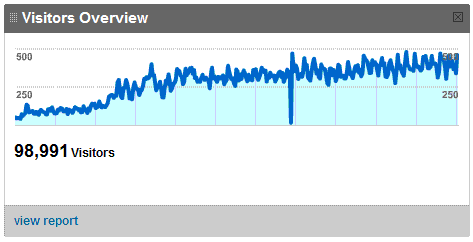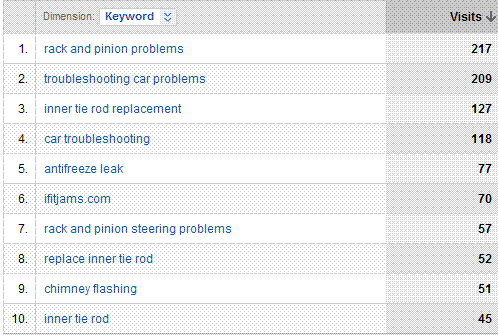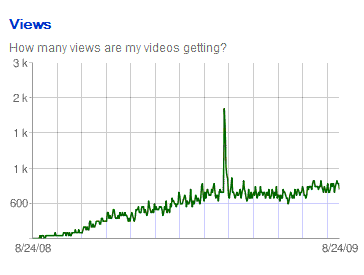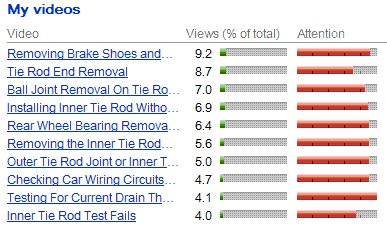The IFITJAMS.COM website is collection of about 20 static pages and a dozen blog posts on the subject of automotive troubleshooting and repair. I don't have any "authority" in the field, I'm strictly a shade tree mechanic, so I think it's a fair proxy for a new author or publisher starting a website with a project in the early draft phase. The total visitor count for the first year fell just shy of 100,000, and the site is now averaging around 400 visitors a day at the end of the slow season.

It's important to note that there are no community features on the website to inflate the visitor numbers. I didn't add a discussion forum or any scheduled content, request subscriptions, etc. Around 80% of the visitors come from search. The top ten search phrases for the month are shown below:

Currently in the sixth spot is the full domain name, IFITJAMS.COM, and just missing the top 10 was the partial domain name, without the COM. I've noticed that many people today navigate to websites they remember by typing the domain name into Google rather than putting it in the address bar, but I believe that in this case, most of people arriving after searching on variations of the domain name are really coming from YouTube. The graph below shows the YouTube video view count, which is on its way towards 1,000 views a day, and the total number of video views for the channel is already over 200,000.

In addition to the little single-take automotive repair videos being far more popular than my self publishing harangues, it turns out that viewers find them far more compelling. The final graph shows the attention span for my top ten auto repair videos, all of which are well over 60%, meaning that people usually watch them straight through:

Before moving on to the new website experiment, and why it's necessary, a few observations on what worked for IFITJAMS. First of all, content worked, both on the website and on YouTube. As an author or a self publisher, content is the one thing you already have plenty of, so it's just a question of packaging it for the Internet. The most popular content on the website is the the troubleshooting flowcharts, which are just a graphical representation of text content. One reason integrated graphics of all types work well on the Internet is because they demonstrate effort on the part of the writer. Blogs and e-mail have made it abundantly clear that for many of us, talk is cheap, but go to the trouble of drawing a graph and people will say, "Hey, this may be worth something." If all you write about are your opinions and heart rending stories about your family, you may build a blog following, but you're never going anywhere with search.
Yet the videos I did for the website were more popular than the website itself. Is this a problem? No, every video view brands the website, and several people a day click the link on the YouTube channel that brings them to the website. If I had written a book on automotive troubleshooting, I could go back and add a banner to the videos announcing it (instantly promoting the book to over 5,000 viewers a week), and continue to produce more videos based on the book content. If you're curious how much time it would take an author to put together all of the content on the website and YouTube, I'd estimate it was on the order of 200 hours, but keep in mind I partially rebuilt a car in the process. Another way of looking it would be that for each hour of time invested, I drew 1,000 viewers on YouTube and 500 readers for the website over the past year, and those numbers will likely rise over the next year or two without any further effort required. If I had really been writing a book about troubleshooing automotive problems, much of the work would have been used for the book as well.
So now we come to the beginning of the new test, which I suspect will prove that starting a new website for each new writing project is both unnecessary and counter-productive. My new writing project will be on the subject of self employment and self sufficiency, something I'm very passionate about as a self publisher. And not surprisingly, I think that most of the advice I see peddled by self employment gurus focuses either on the easy stuff or the unethical approach. Rather than setting up a new domain, I'm simply adding the subject to this website, with a couple new links on the homepage. Also in accordance with my standard practice, I'm posting draft material as I go along, which I'll edit and improve as the ultimate parameters of the project firm up.
The new project starts with the Sole Proprietor blog, which I published over an older blog about investing. I've experimenting with changing the subject of an existing blog in the past, and on the whole, it seems to hurt as much as it helps since any existing links misscategorize the content. But I don't take blogging seriously as a way to draw visitors in any case, I just wanted a simple way to interact with readers who don't like sending direct e-mail. The core of the new project for now will be a collection of pages about taxes for self employed people in the US, which I'm putting in a sub directory.
My ultimate goal is to create a broader guide to business self sufficiency. If I can draw enough interest for the tax nitty-gritty and basic business philosophy that I'll dribble out on the blog at one or two posts a month, I'll tie it all together with some new and existing material about basic home finance for a complete picture of sustainable self suffiency in a self employed business model. It seems to me that there's too great a focus on short-term income in most modern business models, whether it's self employed individuals or giant corporations, when sustainability of the business model should be the primary goal. This doesn't just apply to self publishing where I'll take four titles earning over $12,000 a year over one title earning $50,000 a year every time, but to every small business I've worked in or known about.
2 comments:
Thanks for this Morris. Very interesting stuff, particularly about your video popularity. I think people do want specific how to videos with non-fiction useful books as yours.
I am 9 months into my own site which drives sales for my non-fiction books. I have 2 separate sites for different "brands" and love experimenting with them as well. I have found social media to be turbo-charging traffic but hard to maintain for more than one site.
StumbleUpon has also been a very good source of traffic, perhaps you could consider that to boost your video traffic more?
Thanks, Joanna
Joanna,
I've steered clear of any reliance on social networking for driving traffic, really for three reasons.
First, I never wanted to be perceived as a spammer, repeatedly going back to the same sites and trying to drum up interest.
Secondly, as you mention, the people I know who depend on social networking for traffic have to work at it continually.
Third, and perhaps most important, I question the value of most of the social networking traffic. I've had spikes of traffic from StumbleUpon which added over 5,000 visitors a day to my site for a few days with ZERO impact on sales. It also seems that StumbleUpon and Reddit users don't generate organic links, just votes on those site.
I actually prefer getting Tweeted and reTweeted at this point, because a lot of bloggers seem to monitor Twitter for blog fodder, so at least there's a chance of getting a little link love:-)
Morris
Post a Comment